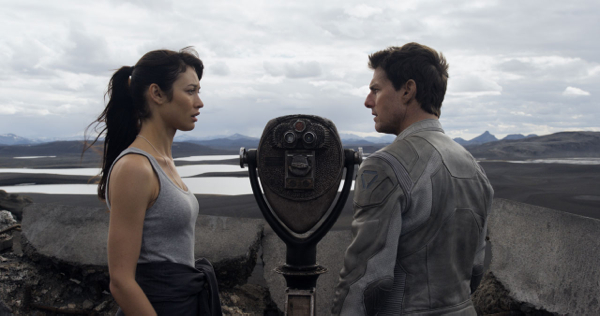Movie review by Greg Carlson
WARNING: The following review reveals key plot information. Read only if you have seen “Oblivion.”
Director Joseph Kosinski, working from his own currently unpublished graphic novel, borrows from so many science fiction texts that genre fans might well pass the unsustainable running time of “Oblivion” tallying the allusions. From any number of episodes of “The Twilight Zone” to quotations of “WALL-E,” “Solaris,” “Moon,” “Minority Report,” and the unavoidable indebtedness to “2001: A Space Odyssey,” Kosinski’s shaky simulacrum labors as a visual concept-in-search-of-a-story that took multiple scribes several rewrites to complete. Many of the harshest critiques have been levied at star Tom Cruise, who continues to look and behave some fifteen to twenty years younger than the July 3, 1962 date on his pilot’s license, but the real trouble with “Oblivion” is the huge, empty vacuum of nothingness suggested by its title.
Long after viewers have sifted through messy exposition belabored by long stretches of redundant voiceover, “Oblivion” adopts a “Matrix” meets “Terminator” view of enslavement or death delivered by artificial intelligence. A gigantic tetrahedral station unimaginatively nicknamed the Tet fills in for HAL 9000/Matrix/Skynet as the movie’s symbol of sentient machinery gone awry. Cruise’s Jack Harper, in partnership with communications officer/lover Victoria Olsen (Andrea Riseborough), works on a desolate Earth to service and repair the intimidating drones that patrol the huge platforms slurping up resources needed to sustain the Tet. No matter how many midnights he skinny-dips with Victoria, Jack cannot shake visions of life before the fall, even if he erroneously believes humans have retreated to the safety of a colony on Saturn’s moon Titan.
Olga Kurylenko, who was three years old when “Risky Business” was released in 1983, plays Julia Rusakova, an astronaut whose frequent appearances in Jack’s dreams portend even deeper significance when she shows up in the flesh aboard a crippled NASA craft. Julia’s arrival shifts the narrative focus of “Oblivion” to a series of creaky revelations that include both the AI shocker and an opportunity to feature Jack versus Jack fisticuffs in a clone showdown. Throw in retreats to Jack’s secret cabin and the mysterious “Scavs,” led by an underutilized Morgan Freeman, and the recipe of “Oblivion” stirs in too many ingredients to be palatable.
Kosinski’s fondness for elegant design rescues “Oblivion” from total catastrophe, but like his debut “Tron: Legacy,” the beauty is only pixel deep and bereft of intellectual sustenance – especially notable when Jack succumbs to that most laughable of action tropes: outrunning the fireball. The vehicle effects work, however, and Claudio Miranda’s frequent, IMAX-ready wide shots frame landscapes that provide the necessary scale for the dragonfly-shaped, iPhallic “bubble ship” flybys. Along with the EVE meets Beholder firepower of the spheroid drones, the sleek, Bell 47 helicopter-inspired “bubble ship” is the film’s most interesting and memorable character.
The post-apocalyptic dystopia of “Oblivion” contains all kinds of markers to lace the unfamiliarity with a sense of the uncanny. Aviator sunglasses and a New York Yankees baseball cap are joined by other iconic symbols of American culture, including “Planet of the Apes”-style glimpses of a half-buried Statue of Liberty and the inexplicable presence of Andrew Wyeth’s “Christina’s World” as a symbol of who knows just what – a reference to Arthur C. Clarke’s “2001” novel, maybe? The danger of inviting a painting like “Christina’s World” to the party is the risk that some viewers will notice its artistic superiority. I can imagine spending two hours revisiting Wyeth’s canvas. “Oblivion,” not so much.
